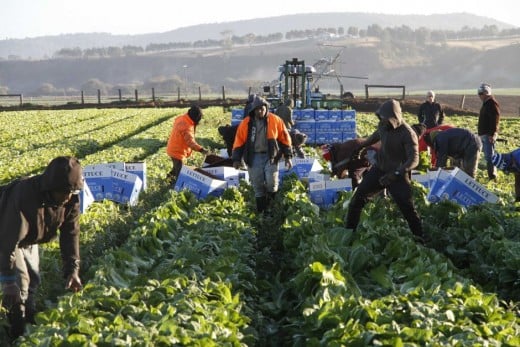Why America's Agricultural Industry Needs Reform: The H-2A Program and the Future of Food Production

America’s agricultural industry has long been the backbone of the nation, supplying food to millions at home and abroad. But today, it faces challenges that could threaten the future of food production. Among these challenges, the H-2A Temporary Agricultural Workers Program stands out as a key factor influencing how farms operate and how the workforce needed to keep them running is managed. While the H-2A program has been instrumental in filling labor gaps, it also highlights a need for reform that could improve efficiency, reduce costs, and secure the future of American food production.

The Role of the H-2A Program
The H-2A program allows agricultural employers to bring foreign workers into the United States for temporary agricultural jobs when there are not enough domestic workers available. This system plays a vital role in industries like fruit picking, fieldwork, and other seasonal tasks where labor shortages are common. With a growing demand for agricultural products, many farmers rely on the H-2A program to ensure that crops are harvested on time and that food production continues without disruption.
However, as necessary as this program has been, it’s not without its flaws. While the H-2A program helps fill labor gaps, it’s also burdened with bureaucratic hurdles that can be costly and time-consuming for farmers to navigate. There are numerous regulations and paperwork requirements, which can slow down the process and create financial strain on farmers who are already dealing with tight margins. And with the current system only allowing workers to stay temporarily, there’s a constant turnover of labor, which can create instability in workforce planning for farms that depend on consistent help.

Need For Reform
The reality is that America’s agricultural system is facing a labor crisis. Many farmers are struggling to find enough workers to meet demand, especially with jobs that are physically demanding and low-paying. At the same time, wages in agriculture continue to rise as workers seek better-paying opportunities in other sectors. The H-2A program is one of the few solutions in place to address this issue, but it needs reform to work better for both farmers and workers.
One area for reform is simplifying the application process. Currently, the paperwork and red tape involved in bringing in H-2A workers can be overwhelming, especially for smaller farms that don’t have the resources to deal with government bureaucracy. Streamlining this process would make it easier for farmers to hire workers when they need them most, without having to navigate a maze of regulations that slow things down.
Another issue is the cost of the program. Farmers are required to pay not only for the wages of their workers but also for transportation, lodging, and other expenses. While these requirements are meant to ensure fair treatment for temporary workers, they can be a significant financial burden for farmers, particularly those with small-scale operations. Adjusting the financial requirements of the program could make it more accessible for farms that are struggling to keep up with rising operational costs.
Furthermore, while the program allows workers to stay temporarily, the lack of a long-term solution creates uncertainty for farmers. Seasonal work can be unpredictable, and having workers constantly rotating in and out of farms is not ideal for productivity. Establishing a more stable workforce, through options for longer-term stays or even permanent residency for certain workers, could give farmers more consistency and better planning for the future.
Looking Ahead: Securing the Future of Food Production
Reforming the H-2A program isn’t just about making life easier for farmers; it’s about securing the future of food production in America. As the demand for food increases, so too will the need for a reliable, dedicated workforce to meet that demand. If the agricultural industry doesn’t adapt to these needs, it could lead to greater instability in food supply, rising prices, and more difficulty in sustaining domestic farming.
By addressing the inefficiencies and challenges of the H-2A program, America’s agricultural industry could become more resilient and competitive on the global stage. Reform could help stabilize the labor market, reduce costs for farmers, and ensure that food production can keep up with the demands of a growing population.
The solution lies in creating a balance between meeting the needs of farmers and protecting the rights of workers. Streamlining regulations, reducing costs, and offering more long-term solutions for workers could help foster a more sustainable agricultural system. If reforms are made, America’s farmers will be better equipped to keep feeding the nation and the world, ensuring that the country’s agricultural future remains bright.
Just My View
America’s agricultural industry is facing serious challenges, and the H-2A program, while helpful, needs reform to secure its future. Simplifying the hiring process and reducing the financial burden on farmers would help them thrive and ensure food production remains a cornerstone of the U.S. economy.
The current system is bogged down by bureaucracy and rising costs, making it harder for farmers, especially smaller ones, to operate efficiently. By streamlining the application process, we could save time and money, allowing farmers to focus on growing food. Additionally, adjusting the financial requirements for housing and transportation could alleviate the strain on farmers who are already struggling with tight margins.
Another critical issue is worker stability. The H-2A program’s temporary nature creates constant turnover, which isn’t ideal for either farmers or workers. Offering more long-term options for workers would provide farms with the consistent labor they need while also giving workers more stability.
Reforming the H-2A program isn’t just about easing burdens—it’s about securing the future of food production in this country. It’s time to make thoughtful changes that will strengthen America’s agricultural sector and ensure that we continue to produce food domestically, without relying on imports.








